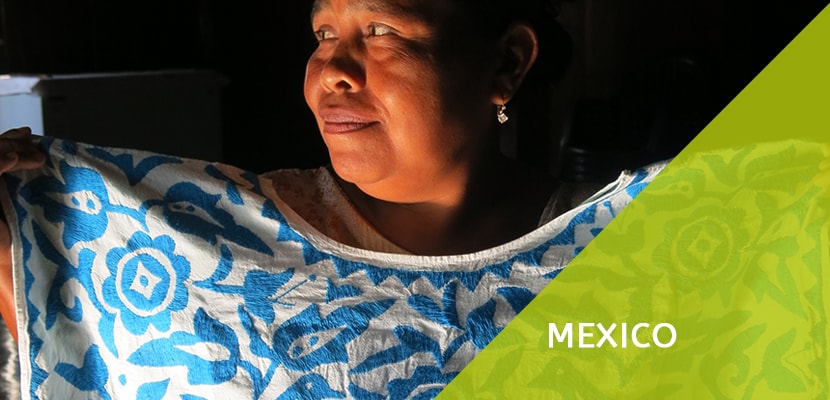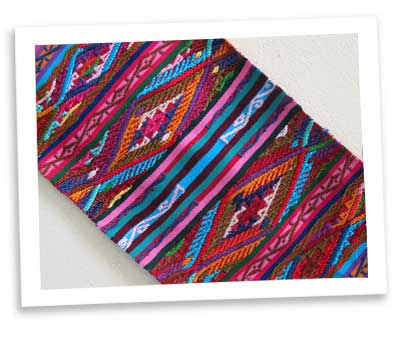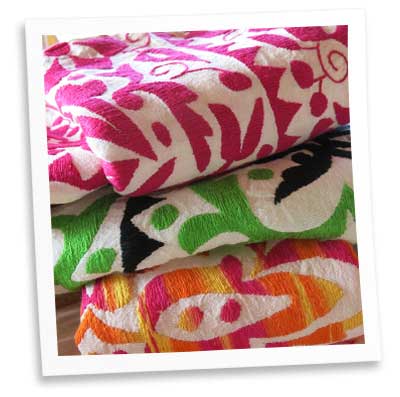
This journey begins in Veracruz, where in addition to visiting the vibrant Port of Veracruz, we’ll explore the extraordinary Museum of Anthropology in Xalapa, to learn about the ancient Olmec, Totonac and other cultures that inhabited this region. Our trip continues into lesser visited regions Veracruz and Oaxaca known as the Papaloapan Basin. Then we will enter La Chinantla, a cultural / natural region located between Veracruz and Oaxaca; between the Gulf of Mexico and the Sierra Juarez mountains. We enter a tropical rain forest, where the landscape varies between lush and tropical (think mangoes and pineapples) to higher elevations where coffee grows and deciduous forests begin. The ethnographic landscape of this region is comprised of Chinantec and Mazatec communities, that we’ll visit. Valle Nacional, San Lucas Ojitlan and San Felipe Usila, are some of them. Their textile traditions are among the richest in Mexico, combining unique iconography in woven and embroidered cloth to make huipiles. This trip also goes to the fascinating region of Tehuacan, Puebla where we’ll meet with the Nahua community of San Gabriel Chilac and the Mixtec palm weavers and the famed potters of Los Reyes Metzontla!


Pre Arrival Day: January 30 (hotel not included in tour cost) Arrive: Welcome Event, Weaving Demo and Music! (Reception)
To welcome the group, we have arranged a welcome fiesta poolside at our hotel. We’ll gather to meet and greet, enjoy a tropical drink, listen to the famed harp music of Veracruz and a big treat will be to meet and honor some very special artisans from a Nahua region in the south of Veracruz, Cosoleacaque.
Day One: January 31, Famed “lechero” breakfast, Depart for Xalapa for visit of Museo de Antropologia and Reception / Private Textile Collection (B, D)
Today is dedicated to learning about the ancient past of Veracruz. We’ll learn about the Olmec, Totonac and other civilizations that were present in this region before the arrival of Cortez. We’ll spend the morning visiting the extraordinary Museo de Antropologia in Xalapa, before attending a private reception to meet with a beloved textile collector of Mexico. We’ll return to Veracruz for a lovely dinner overlooking the ocean.
Day Two: Feb., 1 Transfer to Tuxtepec, stopping in Tlacotalpan, Fashion Show in Tuxtepec! Overnight Tuxtepec (L, D)
Today we begin our journey towards Tuxtepec, but not before a special visit in our favorite town on the shores of the Papaloapan River, Tlacotalpan. Here, we’ll walk the town made famous by Agustin Lara and home to some of the best “jaraneros” of Veracruz. We’ll meet a wonderful children’s music and dance troupe, to learn of the history and cultural significance of the “fandango”. Get your dancing shoes on! Arriving in Tuxtepec, we’ll settle into our hotel to prepare for another extravaganza: a fashion show of the dress from the region, including Chinantec and Mazatec dress from communities such as: Valle Nacional, San Lucas Ojitlan, San Felipe Usila, Jalapa de Diaz, Huatla de Jimenez, San Pedro Ixcatlan. Hopefully you’ve kept your dance shoes on, as we’ll learn some steps from the famed “Baile Flor de Pina” dance, made famous at the Guelaguetza Festival.
Day Three: Feb. 2, Valle Nacional, Overnight Tuxtepec (B, L)
Today, a treat is in store, as we’ll spend our day in the extraordinary Chinantec region of Valle Nacional. Here, we’ll meet with community members and weavers from Rancho Grande, Yetla and other communities in this lovely valley in the lower Chinantec region. We’ll learn about initiatives to revive the ancient brocade weaving technique, that elderly members of the community passed on to subsequent generations. Also, we’ll learn of the various “tree of life” motifs that are embroidered on the hupiles of this region. We’ll enjoy an expo-venta, weaving and motif demo on the shores of the river that runs through this ancient community in La Chinantla.
Day Four: Feb. 3, San Felipe Usila, Overnight Tuxtepec (B, L)
Today we enter an “other worldly” natural and cultural environment by visiting San Felipe Usila, a Chinantec community. We’ll be met by community members and first enjoy a home visit and home cooked meal of “amarillo” the special mole from this region. We’ll meet with the artisans for an expo-venta and demo of their highly skilled brocade weaving technique. Weavers from neighboring Tlacoatzintepec will join us, as well. We’ll end our visit by experiencing the singular soup called, “caldo de piedra”. Stones aren’t eaten but they are used to cook the soup! Returning to Tuxtepec, our evening is at leisure.
Day Five: Feb. 4, San Miguel Soyaltepec and San Lucas Ojitlan, Overnight Tuxtepec (B, L)
Today we’ll visit the Chinantec community of San Lucas Ojitlan, and will be met by community members and artisans. We’ll learn about their daily wear, media gala and gala huipiles that are hand woven on a backstrap loom, and embroidered with the iconography of the region, to include: Quetzalcoatl, double headed eagle, peacocks, humming birds. Leaving Ojitlan, we’ll visit with a Mazatec community, on the shores of the Miguel Aleman dam. While the dam is beautiful (today looks like a lake) we’ll also learn about the hidden story behind most dams: destruction of natural and cultural landscapes. The community we’ll meet with is San Miguel Soyaltepec, and today the only way to arrive is by boat. The artisans will meet us on the shores of the dam, in the community of San Pedro Ixcatlan. We’ll enjoy an expo-venta of their gorgeous embroidered huipiles, laden with birds and flowers. We’ll also enjoy a lunch of mojarra, farm raised on the presa, in a sustainable manner.
Day Six: Feb. Feb. 5, Tuxtepec to Orizaba, Overnight Orizaba (B)
Before we leave, we’ll have one last “expo-venta” from some of the top textile collectors of the region. Sometimes they rotate their pieces and are willing to part with a few. Then, we say goodbye to the region, as we make our way to Orizaba, Veracruz, a town in the shadows of the largest volcano in Mexico: Orizaba. Arriving, we are at leisure to enjoy this charming town, perhaps step into the Museo del Estado, art museum to see regional art.
Day Seven: Feb. 6, Orizaba to Tehuacan, Visit Los Reyes Metzontla and Botanical Garden in the Tehuacan Bio Reserve (B, L)
We make our way over the mountain pass, to enter the Valley of Tehuacan, a valley where some of the earliest domesticated corn was found, and home to the Nahua people. We’ll go straight to our destination, in the heart of the Tehuacan Bio Reserve, a UNESCO World Heritage site, both for its natural and cultural uniqueness. We begin with a visit in Los Reyes Metzontla, a Nahua community that makes pottery in the same way they did over 3,000 years ago. Their burnishing technique make this pottery among the most beautiful in Mexico. We’ll enjoy a visit and lunch in the Tehuacan Bio Reserve. Return to hotel for leisure time.
Day Eight: Feb. 7, San Gabriel Chilac, Museo de Agua, Transfer to Oaxaca (B, L)
Today we visit a special Nahua community in the Tehuacan Valley, San Gabriel Chilac. We’ll learn of their ancient customs and rituals in dance, ceremony and dress. Their blusa is considered the “china poblana” blouse! We’ll also enjoy a cleansing ceremony with fragrant herbs, before we enjoy a visit and meal at the Museo del Agua, a living museum dedicated to reviving ancient water conservation practices and to reviving ancient and nutrient rich amaranth. In fact, our meal will be based on dishes using amaranth! We’ll also learn to make amaranth “alegrias”, before we transfer to Oaxaca City.
Day Nine: Feb. 8 Southern Craft Route! (B, L)
Today, we’ll travel in the southern valley of Oaxaca’s Central Valleys to explore the craft communities of Ocotlan, San Antonino, Santo Tomas Jalieza, to see the traditional pottery, embroidery, weaving and wood carvings of this famed craft route.
Day Ten: Feb. 9, Teotitlan del Valle and Centro de Arte Zapoteco Bii Dauu, Free Afternoon in Oaxaca City, Farewell Dinner (B, L, D)
Today we spend ½ day with our friends in Teotitlan del Valle, Centro de Arte Textil Zapoteco Bii Dauu to learn of their work with color trends and contemporary use of ancient processes and techniques. We’ll enjoy the best quesadillas you’ve ever had…oh and some mezcal too! Returning to Oaxaca City, our afternoon is at leisure, before we enjoy a fun and festive farewell dinner.
textiles motifs
textile
textiles
textiles
textiles
working
textiles
the tools
textiles
vegetation
chinantla- boy
chinantla landscape
town church
flora
donkey
corn
making tortillas
the menu
Welcome to San Felipe Usila
la casa del pueblo
la chinantla
boat
ladies
landscape
landscape
landscape
4 pineapple for 25 pesos
pottery
By the river
The river is waiting
Choosing the rocks
preparing the fire
rocks on fire
rocks heating
preparing the ingredients
the vegetables
the fish
preparing the dish
fresh shrimp
the fire is over
choosing the rocks
putting the hot rock
boiling
ready
canoe passing by
coffee berries
taking coffee’s pulp off
drying the grains
coffee drying
coffee is ready